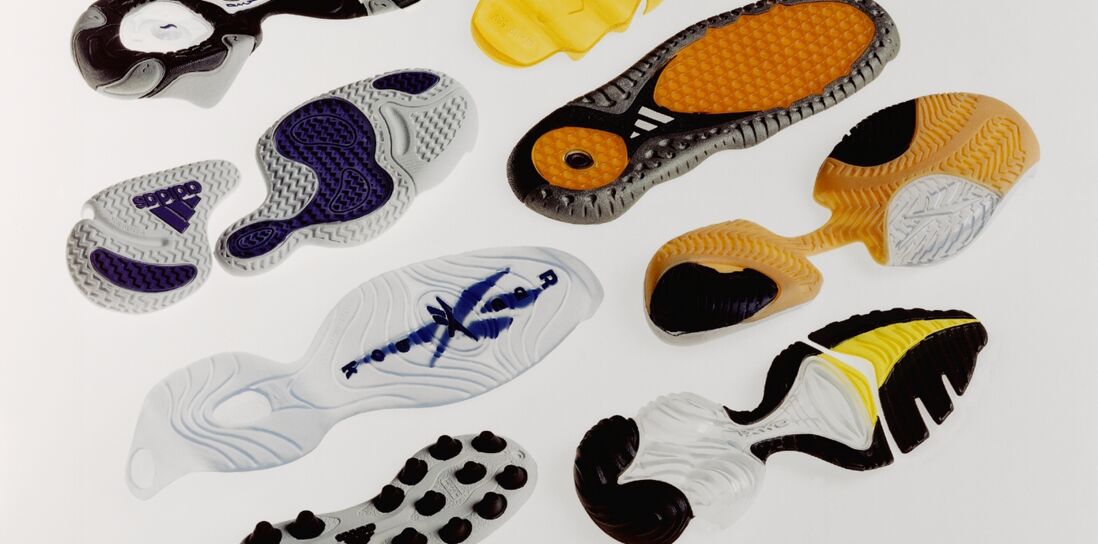
Silica and silane in shoe soles
On the go on lightweight and dynamic soles with good grip
Running shoes, hiking boots, everyday and work shoes – shoe soles must meet a variety of demands depending on the function they are to fulfill and the situations in which they are worn. They must carry the wearer’s weight while also cushioning the foot and absorbing the shocks caused by movements. They are subjected to different ground surfaces and temperatures and are intended to protect the wearer’s feet when walking, running and standing. Thus, soles on hiking boots should be especially robust, while soles on tennis shoes should be slip-proof, lightweight and flexible. Correspondingly, the material from which the shoe soles are made must be customized to match the different functions and shoe types.
Light-colored reinforcement systems for shoe soles with a contemporary design
Shoe soles belong to the category of mechanical rubber goods. The starting material is a rubber mixture that is mixed with additional components and subsequently vulcanized, forming a plastic elastomer known as rubber. A key component of this mixture is the reinforcing fillers that improve the performance of the end product.
In the past, carbon black was the virtually exclusive choice for shoe soles; however, as the material was black, it was not suited for light-colored or transparent shoe soles. That is why either precipitated (Performance Silica) or fumed silica (AEROSIL® fumed silica) have established themselves as the standard reinforcing filler additive, depending on the application. These additives impart light-colored reinforcement, can easily satisfy fashion-related requirements for modern shoe designs and mean that the soles no longer leave any black marks on the floor, as was often the case in sports facilities in the past.
Better yet, performance is significantly improved: The shoe soles exhibit good elastic recovery behavior and retain their form even when subjected to fluctuating temperatures or other physical and chemical influences. Their wear-and-tear resistance is also increased significantly – even when subjected to high stress loads, the soles do not crack or break, and the sport shoes have a longer service life overall.
Silica/silane system for high-performance shoe soles
However, polar silica is not compatible with non-polar rubber without the use of additional additives. To be able to impart their reinforcing effect, they must first be combined with silanes. The various functional groups of silanes ensure the two materials are chemically crosslinked when mixing and vulcanizing the rubber formulation. An additional benefit of the silica/silane combination is that the formulation is then much easier to process.
Which rubber mixture, and thus which silica and silane, is used depends on a variety of parameters such as the type of surface and stresses it will be subjected to. When manufacturing shoe soles, the use of polyisoprene rubber (IR) or polybutadiene rubber (BR) is highly common; the latter is mixed with other types of rubber such as natural rubber (NR) or styrene-butadiene rubber (SBR). IR is characterized by its high strength and flexibility, low level of deformation and outstanding performance when exposed to low temperatures. It is easier to process compared to natural rubber. However, it has a lower tear resistance.
In contrast, BR is extremely hard and exhibits good UV, oxygen and ozone resistance, and better abrasion resistance and flexibility at low temperatures. Adding a low silane concentration in both cases results in even better abrasion and tear resistance. Moreover, this also reduces the viscosity, which in turn improves the processability of the formulation.
Silica and silanes from a single source
In addition to the precipitated silica from the ULTRASIL® brand and fumed silica (AEROSIL® products), Evonik offers a wide range of sulfur silanes, such as Si 69. Equally, silanes with specialty functions (such as amino, vinyl and other silanes) are available that are produced and sold under the brand name Dynasylan®. Moreover, specialty mixtures comprising ULTRASIL® and various sulfur-functional silanes are available, which are marketed under the COUPSIL® product family. Thus, customers can rely on a wide range of different silanes and silica products that are specifically tailored to suit their application areas and requirements.
The benefits at a glance:
- High durability
- High abrasion and tear resistance
- Minimal wear and tear
- Good temperature resistance
- Low compression set
- Low viscosity of the mixture
